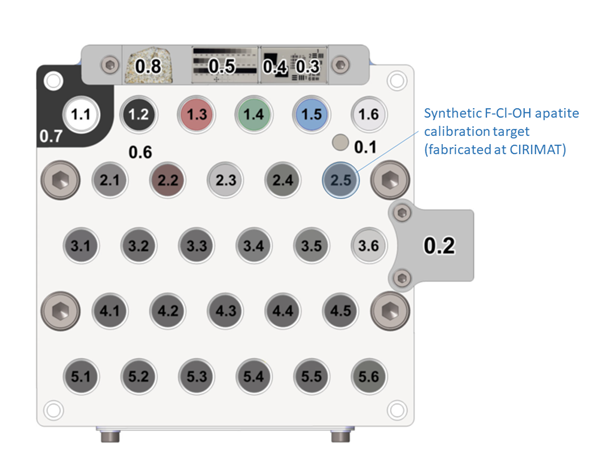A reference compound to calibrate the analyzer of the Mars rover Perseverance
How do you calibrate a device once on Mars? On board the “Perseverance” rover, the SuperCam module will have a series of reference samples to improve the accuracy of mineralogical analysis of the surface of the Red Planet. Researchers from CIRIMAT (CNRS/Toulouse INP/Université Toulouse 3 Paul Sabatier), in interaction with the Raimond Castaing center (CNRS/Université Toulouse 3 Paul Sabatier/Toulouse INP/INSA Toulouse) and the PNF2 (CNRS) have prepared one of these calibration targets at the request of IRAP (CNRS/Université Toulouse Paul Sabatier/CNES). The selection and validation process of the calibration targets, including those prepared by other laboratories, is published in Space Science Reviews.
To take over from the Mars rover Curiosity, NASA’s Mars 2020 mission is delivering a new rover, Perseverance, to the Red Planet. The device is equipped with the SuperCam multi-analytical module, which is more powerful than the ChemCam of Curiosity. This on-board laboratory contains in particular a laser-induced plasma atomic emission spectrometer (LIBS), in charge of studying Martian rocks and searching for possible traces of biological activity. To remain accurate despite the harsh and changing conditions on Mars, LIBS must be regularly calibrated. To do this, it carries laboratory-designed samples with a known composition to allow analysis of rocks and reference compounds under identical conditions. Researchers from the Centre interuniversitaire de recherche et d’ingénierie des matériaux (CNRS/Toulouse INP/Université Toulouse 3 Paul Sabatier), supported by colleagues from the Institut de recherche en astrophysique et planétologie (CNRS/Université Toulouse 3 Paul Sabatier/CNES), the Raimond Castaing Microcharacterization Center (CNRS/University of Toulouse Paul Sabatier/Toulouse INP/INSA Toulouse) and the National Flash Sintering Platform (PNF2, CNRS) have designed a calibration target for SuperCam from scratch. In total, thirty-six different calibration pellets are installed on a sample holder designed in Spain, and the LIBS analyzer will be able to select the relevant targets according to the rocks analyzed.
The target made in Toulouse is a calcium phosphate that is both hydroxylated, fluorinated and chlorinated, in the form of an apatite, a type of mineral found, among others, on Mars. This pellet will allow SuperCam to be calibrated specifically to look for light elements such as fluorine, chlorine and hydrogen, as well as two elements found in mineralogy: phosphorus and calcium. The apatite, first obtained in powder form, was then consolidated by “flash sintering”, i.e. via extremely rapid heating to give it the strength needed to endure the eight months in the vacuum of space during the journey to Mars, and the entire duration of the mission on its inhospitable surface. Six replicas of the pellets have been designed and tested, notably by electron microprobe. Only one of them was taken on board at the start of the Mars 2020 mission last July. The remaining replicas will serve as references for further studies on Earth. The researchers also consolidated pellets from other national teams. The rover is scheduled to arrive on Mars in February 2021.

Further Resources
- Scientific paper : SuperCam Calibration Targets: Design and Development, J. A. Manrique, G. Lopez-Reyes, A. Cousin, F. Rull, S. Maurice, R. C. Wiens, M. B. Madsen, J. M. Madariaga, O. Gasnault, J. Aramendia, G. Arana, P. Beck, S. Bernard, P. Bernardi, M. H. Bernt, A. Berrocal, O. Beyssac, P. Caïs, C. Castro, K. Castro, S. M. Clegg, E. Cloutis, G. Dromart, C. Drouet, B. Dubois, D. Escribano, C. Fabre, A. Fernandez, O. Forni, V. Garcia-Baonza, I. Gontijo, J. Johnson, J. Laserna, J. Lasue, S. Madsen, E. Mateo-Marti, J. Medina, P.-Y. Meslin, G. Montagnac, A. Moral, J. Moros, A. M. Ollila, C. Ortega, O. Prieto-Ballesteros, J. M. Reess, S. Robinson, J. Rodriguez, J. Saiz, J. A. Sanz-Arranz, I. Sard, V. Sautter, P. Sobron, M. Toplis & M. Veneranda, Space Science Reviews (2020)
IRAP Contacts
- Agnès Cousin, agnes.cousin@irap.omp.eu
- Sylvestre Maurice, sylvestre.maurice@irap.omp.eu
- Olivier Gasnault, olivier.gasnault@irap.omp.eu
- Olivier Forni, olivier.forni@irap.omp.eu






